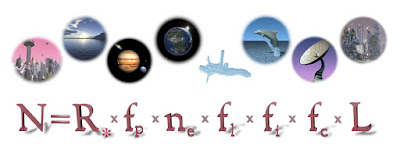The Drake Equation was developed by Frank
Drake in 1961 as a way to focus on the factors which determine how many
intelligent, communicating civilizations there are in our galaxy.
The Drake Equation is:
The equation can really be looked at as a number of questions:
N* represents the number of stars in the Milky Way Galaxy
Question: How many stars are in the Milky Way Galaxy?
Answer: Current estimates are 100 billion.
Answer: Current estimates are 100 billion.
fp is the fraction of stars that have planets around them
Question: What percentage of stars have planetary systems?
Answer: Current estimates range from 20% to 50%.
Answer: Current estimates range from 20% to 50%.
ne is the number of planets per star that are capable of sustaining life
Question: For each star that does have a planetary system, how many planets are capable of sustaining life?
Answer: Current estimates range from 1 to 5.
Answer: Current estimates range from 1 to 5.
fl is the fraction of planets in ne where life evolves
Question: On what percentage of the planets that are capable of sustaining life does life actually evolve?
Answer: Current estimates range from 100% (where life can evolve it will) down to close to 0%.
Answer: Current estimates range from 100% (where life can evolve it will) down to close to 0%.
fi is the fraction of fl where intelligent life evolves
Question: On the planets where life does evolve, what percentage evolves intelligent life?
Answer: Estimates range from 100% (intelligence is such a survival advantage that it will certainly evolve) down to near 0%.
Answer: Estimates range from 100% (intelligence is such a survival advantage that it will certainly evolve) down to near 0%.
fc is the fraction of fi that communicate
Question: What percentage of intelligent races have the means and the desire to communicate?
Answer: 10% to 20%
Answer: 10% to 20%
fL is fraction of the planet's life during which the communicating civilizations live
Question: For each civilization that does communicate, for what fraction of the planet's life does the civilization survive?
Answer: This is the toughest of the questions. If we take Earth as an example, the expected lifetime of our Sun and the Earth is roughly 10 billion years. So far we've been communicating with radio waves for less than 100 years. How long will our civilization survive? Will we destroy ourselves in a few years like some predict or will we overcome our problems and survive for millennia? If we were destroyed tomorrow the answer to this question would be 1/100,000,000th. If we survive for 10,000 years the answer will be 1/1,000,000th.
Answer: This is the toughest of the questions. If we take Earth as an example, the expected lifetime of our Sun and the Earth is roughly 10 billion years. So far we've been communicating with radio waves for less than 100 years. How long will our civilization survive? Will we destroy ourselves in a few years like some predict or will we overcome our problems and survive for millennia? If we were destroyed tomorrow the answer to this question would be 1/100,000,000th. If we survive for 10,000 years the answer will be 1/1,000,000th.
When all of these variables are multiplied together when come up with:
N, the number of communicating civilizations in the galaxy.
The real value of the Drake Equation is
not in the answer itself, but the questions that are prompted when
attempting to come up with an answer. Obviously there is a tremendous
amount of guess work involved when filling in the variables. As we learn
more from astronomy, biology, and other sciences, we'll be able to
better estimate the answers to the above questions.
In 1960 Dr. Frank Drake conducted the
first organized search for intelligent extraterrestrial radio signals,
known as “Project OZMA”, utilizing the radio telescope at the National
Radio Astronomy Observatory, Green Bank, West Virginia. Dr. Drake,
currently the Director for the Carl Sagan Center for the Study of Life
in the Universe, Chairman Emeritus of the SETI Institute’s Board of
Trustees and Emeritus Professor of Astronomy and Astrophysics at the
University of California at Santa Cruz, devised an equation for
“estimating the number of technological civilizations that may exist in
our galaxy” (see http://www.seti.org).
Known as “The Drake Equation”, this series of mathematical factors has
become generally accepted by many scientists as a valuable tool in the
search for life in the cosmos. Some scientists believe that the Drake
Equation could someday be as important as Einstein’s E=mc2 theory.
BBC Four Documentary, The Search for Life: The Drake Equation- Premiere date Tuesday 14 December 2010.
in this docu they re-examen the numbers beeing used by drake in 1961
the numbers get updated to our current level of knowledge about astronomy
and guess what ....


Geen opmerkingen:
Een reactie posten